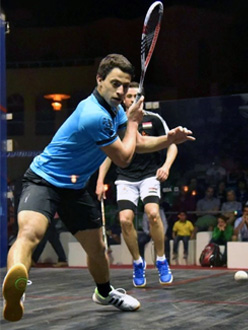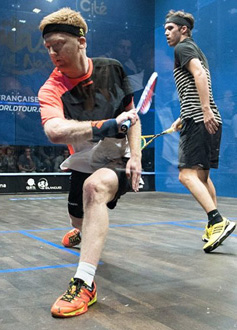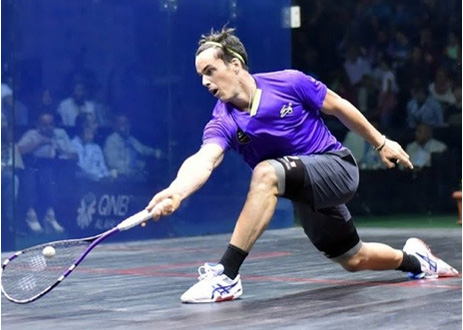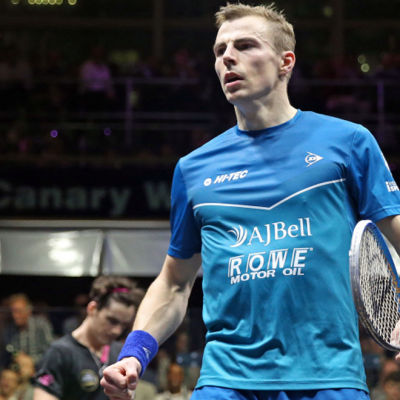When you watch top-level squash, or any sport, executed with grace, flow, timing, rhythm and skill do you ever wonder “how are they able to do that time and time again so effortlessly?”
Athletes like Roger Federer, Lionel Messi, Sachin Tendulkar and Amr Shabana come to mind immediately. They are able to grace their arena of play with a sixth sense as such and this seems to give them an air of superiority. You’ll often see a highly ranked player have the knack to simply walk onto balls that us mere mortals would be scrambling to get to, let alone have the ability to be relaxed and have options to play a range of shots.
“A good hockey player plays where the puck is, a great hockey player plays where the puck is going to be!”
This skill is underpinned by the fact these players have a focussed and heightened awareness of their environment which allows them to naturally anticipate the shot and area their opponent is about to play to. They start to drift and move to the correct area of the court even before the ball has been struck and this buys them valuable split seconds, which in a game so variable and dynamic as squash is a big marginal gain and when this is accumulated over time it has the ability to really limit your opponents thinking and reaction time and builds pressure on them with very low risk to yourself.
The few times I’ve been “lucky enough” to take to the court with some of the top 10 players, it has been a claustrophobic experience. The court felt tiny in regards to where I was able to hit to and felt massive in regards to the distances I had to cover. Even with some good accurate hitting from myself most of my shots were pounced on and I was exposed time and time again.
Over the course of this happening continually for 20-30 minutes it felt like I had completely exhausted all my resources both physically and mentally and I had a feeling of “this player is inside of my head” as each shot was being read earlier and earlier the longer the match went on. This was no surprise as each time I played a certain shot or had a certain response these high-level players had the ability to log and store this data and have it there to also compare to other numerous times it had happened with previous opponents. Each time I played a shot it felt like I was showing my cards and this gave these players even more clues and prompts as to where each shot was going to end up.
Two players that come to mind immediately that made me feel like this were Nick Matthew and Peter Nicol. Their game was based around a high press on the T taking lots of volleys and starving the opponent of time when the correct ball was there. Once they had started to read the pattern of play and the way I hit the ball the pressure started to build pretty quickly after that and the game ran away quickly. Maybe some of you can think of different times and matches that this would have happened to you?
So how do we try to improve this particular skill in our games on the court?
There is a process that I believe has to happen and can be trained but the best players around will unlikely even know what their process is and not be able to identify or verbalise it. Saying that, the players have the ability to watch, I mean REALLY watch their opponents.
There is a slight misunderstanding when someone tells you to “watch the ball!” Yes, this is important, yes, this is obvious and yes it should be done BUT your focus should shift from tracking the ball to really watching your opponent. The early sighting of the ball and picking up its trajectory and endpoint is your first port of call, but quite soon after that, you should try and ‘zoom out’ your field of vision and not just get too stuck on staring at the ball and being caught ball watching. At a certain point, there will no longer be any clues or propts in the ball as to where it is going to do. The ability to zoom out like a camera lens and shift your focus onto your opponent now becomes the priority. How the opponent is addressing the ball and their racket position are where the next clues are going to come from that will telegraph to you what the most likely response will be.
You need to look for the obvious clues first, things such as opponents racket height (attacking or defending), opponents body position (strong base or extended lunge) and position of ball in relation to their body (in front, side-on or behind).
Once you can pick these clues up in a split second then you should start to create patterns about the most common responses from such positions. If you look at the images you will notice these key tells that will help you to anticipate where the ball is going:
 Fares Dessouki:
Fares Dessouki:
• High racket position (attacking)
• Good shoulder rotation and momentum into the ball (strong base)
• Ball slightly front but also going to be side-on at impact
Shot: likely to be an attacking straight drive low and deep
 Tom Richards:
Tom Richards:
• Low racket position with cocked wrist (defending but able to straighten)
• Long lunge onto back leg and lots of rotation with bodyweight going backwards towards the corner (strong but defensive base)
• Ball travelling behind player
Shot: likely to be a straight chip ball with not much pace
 Paul Coll:
Paul Coll:
• Low racket position and long extended grip (defensive with no power)
• Body position low and extending forwards with a long lunge
• Ball very far in front of player and low
Shot: likely a push drop shot or maybe if skilful enough a lob
These are 3 relatively simple examples but ones that need to be seen by you the player and to have proactive anticipation to the area the clues are telling you the ball will go. What I like about all 3 of these pictures is the player watching is in the levitated position nice and light and about to activate their split-step explosively towards the area the ball will end up. If you have a wide base that is glueing your feet to the floor, then your reaction time will be severely reduced and you’ll likely always be playing catch-up to get the ball back and feeling rushed rather than flowing onto the shot with time and options.
In summary, the process that should happen would be along these lines immediately after you’ve hit your shot:
- Pick up the flight of your shot as early as possible
- Start to ‘zoom out’ and try and use periphery vision as to your opponent’s position
- Start to look for the clues and prompts in your opponent as to WHEN they are going to hit the ball
- Start to look for clues in your opponents swing, body position and ball position (zooming back in)
- Activate your levitating position in order to split-step in the correct direction
- Pick up the flight of the ball very soon after your opponent has made contact and your momentum should already at this point be activated
There is no quick and easy method to develop this skill and it takes time to bed it in, but if you are open-minded and let the information come to you and have the ability to log situations and responses time after time you’ll find your natural ability to read the game and anticipate better will start to improve and you’ll enjoy the feeling of moving onto the ball earlier.
You’ll ideally find you’ll frustrate your opponent by having the ability to “get inside of their head” and move onto a shot even before they know they are going to hit it at times. What a lovely feeling that is and one that should keep you craving the game even more.
Jesse Engelbrecht
Want to learn more about reading your opponent?
Check out this series where Lee Drew walks us through everything you need to know about reading your opponents and teaches us how to get one step ahead of them!
Watch now
